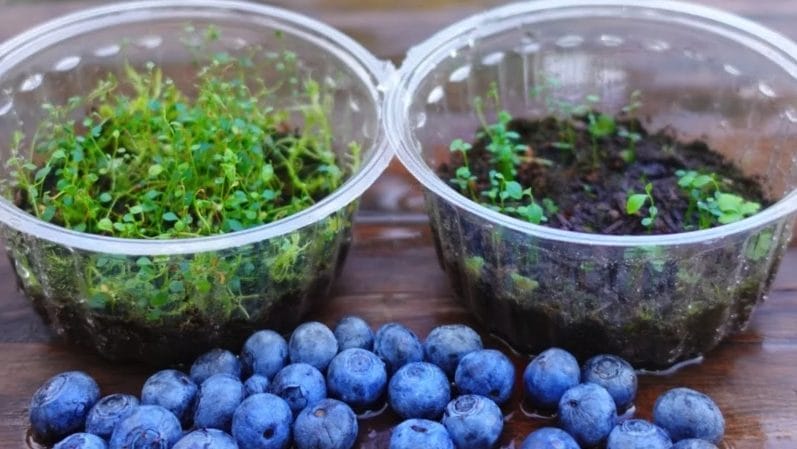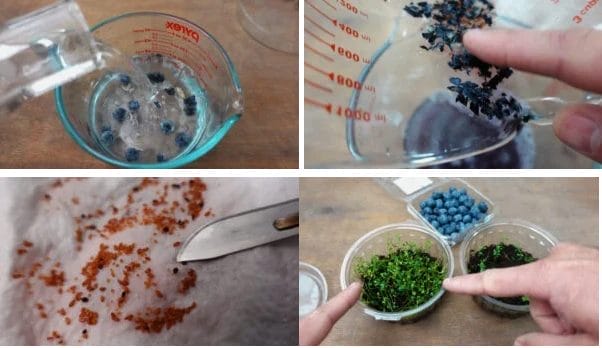How to Grow Blueberry Plants from Store-Bought Blueberries

Growing your own blueberry plants from store-bought blueberries is an exciting and rewarding experience for any gardening enthusiast. Not only does it provide a sense of accomplishment, but it also allows you to enjoy the freshest, most flavorful blueberries right from your own backyard. Blueberries are known for their numerous health benefits, including being rich in antioxidants, vitamin C, and dietary fiber. By growing your own blueberry plants, you can ensure that your fruit is free from harmful pesticides and chemicals, and you can enjoy the satisfaction of nurturing your plants from seed to harvest. In this article, we will explore two methods for growing blueberry plants from store-bought blueberries: seed extraction with pulp and direct planting of seeds. We will guide you through the process step-by-step, providing tips and tricks along the way to help you achieve the best results. Whether you are a seasoned gardener or a beginner, this article will provide you with the knowledge and confidence to start your own blueberry patch and enjoy the sweet rewards of your labor.
Choosing the Right Blueberries
The success of growing blueberry plants from store-bought blueberries begins with selecting the right fruit. When choosing blueberries for seed extraction, look for large, ripe, and healthy berries. Larger blueberries tend to have more developed seeds, increasing the chances of successful germination. Ripe blueberries will be plump, with a deep blue color and a slight give when gently squeezed. Avoid berries that are shriveled, moldy, or have visible damage, as these may not contain viable seeds.
Consider whether to use organic or non-organic blueberries for your seed extraction project. Organic blueberries are grown without the use of synthetic pesticides and fertilizers, which may be preferable if you want to maintain an organic garden. However, non-organic blueberries can still be used successfully, as the seeds will be cleaned and separated from any potential residues during the extraction process.
Some blueberry varieties are better suited for seed extraction than others. Rabbiteye blueberries (Vaccinium virgatum) and lowbush blueberries (Vaccinium angustifolium) are known to have higher seed germination rates compared to highbush blueberries (Vaccinium corymbosum). If possible, try to select these varieties for your seed extraction project. However, if these specific varieties are not available, don’t be discouraged – any type of blueberry can potentially yield viable seeds with proper care and attention.
Method 1: Seed Extraction with Pulp

Step 1: Extracting the Seeds
To begin the seed extraction process, start by cutting open the blueberries with a sharp knife. Carefully remove the pulp and seeds from the berries, being sure to keep as many seeds intact as possible. Place the pulp and seeds in a bowl or container.
Next, separate the seeds from the pulp by gently mashing the mixture with a fork or your fingers. The goal is to break down the pulp while keeping the seeds whole. Add a small amount of water to the container to help loosen the pulp and make the separation process easier.
Step 2: Preparing Seeds for Germination
Once you have separated the seeds from the pulp, it’s time to prepare them for germination. Add enough water to the container to create a moist environment for the seeds. This will help to further separate the seeds from any remaining pulp and create a suitable environment for germination.
Allow the mixture to sit for a few hours or overnight. During this time, the heavier, viable seeds will sink to the bottom of the container, while the lighter pulp and non-viable seeds will float to the top.
After the mixture has settled, carefully pour off the excess water and pulp, leaving the viable seeds at the bottom of the container. Rinse the seeds thoroughly with clean water to remove any remaining pulp or debris.
Step 3: Storing the Seeds
Once the seeds have been cleaned, spread them out on a paper towel to dry. Allow the seeds to air dry completely, which may take several hours or overnight, depending on the humidity and temperature of your environment.
When the seeds are completely dry, they can be stored for future use. Place the dried seeds in a paper envelope or a sealed container and store them in a cool, dry place. Properly stored blueberry seeds can remain viable for up to a month, giving you plenty of time to prepare for planting.
Method 2: Direct Planting of Seeds

Step 1: Preparing the Planting Medium
To successfully grow blueberry plants from seeds using the direct planting method, it’s essential to start with the right planting medium. Blueberries prefer well-draining, acidic soil with a pH between 4.5 and 5.5. To create an ideal growing environment, choose a high-quality, acidic potting mix specifically formulated for acid-loving plants like blueberries, rhododendrons, and azaleas.
To further enhance the soil’s fertility and structure, consider adding aged compost or pine bark to the potting mix. Compost will provide essential nutrients to the growing seedlings, while pine bark helps to improve soil aeration and drainage. Mix the compost or pine bark thoroughly with the potting soil to create a homogenous blend.
When selecting a container for planting, choose one with adequate drainage holes to prevent water from accumulating at the bottom, which can lead to root rot. Fill the container with the prepared potting mix, leaving about an inch of space at the top for watering.
Step 2: Planting the Blueberry Seeds
With your planting medium prepared, it’s time to sow the blueberry seeds. Sprinkle the seeds evenly over the surface of the soil, taking care to distribute them as evenly as possible. If some of the seeds are clumped together, gently separate them to ensure that each seed has enough space to germinate and grow.
After distributing the seeds, lightly cover them with a thin layer of soil, about 1/8 to 1/4 inch deep. Blueberry seeds require light to germinate, so be careful not to bury them too deeply. Gently tamp the soil surface to ensure good seed-to-soil contact, which will help with moisture retention and germination.
Step 3: Providing the Right Environment
To encourage germination, it’s crucial to maintain a consistently moist environment for the blueberry seeds. Use a spray bottle or a fine-mist watering can to gently mist the soil surface, being careful not to disturb the seeds. The soil should be kept moist but not soggy, as excessive moisture can lead to seed rot or damping off.
To maintain humidity and promote germination, cover the container with a clear plastic lid or wrap. This will create a mini-greenhouse effect, trapping moisture and heat to create an ideal environment for seed germination.
Place the covered container in a bright, warm location with temperatures between 65-75°F (18-24°C). Blueberry seeds do not require direct sunlight to germinate, but they do benefit from bright, indirect light. A sunny windowsill or a grow light setup can provide the necessary light for successful germination.
To further encourage germination, consider providing bottom heat to the container. You can use a heat mat designed for seed starting or place the container on top of a warm appliance, such as a refrigerator or water heater. Bottom heat will help to maintain a consistent soil temperature, which can speed up the germination process.
Caring for Blueberry Seedlings
| Care Aspect | Description |
|---|---|
| Watering | Keep the soil consistently moist but not waterlogged. Water gently to avoid disturbing the seedlings. |
| Light | Provide bright, indirect light for at least 6-8 hours per day. Avoid direct sunlight, which can scorch the tender seedlings. |
| Transplanting | When seedlings have developed several true leaves, transplant them into individual pots or a larger container. Be gentle to avoid damaging the delicate roots. |
| Hardening Off | Before transplanting seedlings outdoors, gradually acclimate them to outdoor conditions by exposing them to increasing amounts of sunlight and wind over a period of 7-10 days. |
As your blueberry seedlings grow and develop, it’s essential to provide them with proper care to ensure their health and vitality. One of the most critical aspects of seedling care is watering. Blueberry seedlings require consistently moist soil to thrive, but it’s important to avoid overwatering, which can lead to root rot and other fungal diseases. Water the seedlings gently, using a fine-mist watering can or a spray bottle, to avoid disturbing the delicate roots and stems. Check the soil moisture daily, and water when the top inch of soil feels dry to the touch.
In addition to proper watering, blueberry seedlings need adequate light to grow and develop. Provide your seedlings with bright, indirect light for at least 6-8 hours per day. If you’re growing your seedlings indoors, place them near a sunny window or under grow lights. Avoid exposing the seedlings to direct sunlight, which can scorch their tender leaves and stems.
As your blueberry seedlings grow larger and develop several true leaves, it’s time to consider transplanting them into individual pots or a larger container. Transplanting allows the seedlings to develop a more robust root system and provides them with the space they need to grow and mature. When transplanting, be gentle to avoid damaging the delicate roots. Use a well-draining, acidic potting mix, and make sure the new container has adequate drainage holes to prevent water from accumulating at the bottom.
Before transplanting your blueberry seedlings outdoors, it’s crucial to harden them off to acclimate them to outdoor conditions. Hardening off is the process of gradually exposing the seedlings to increasing amounts of sunlight, wind, and temperature fluctuations over a period of 7-10 days. Start by placing the seedlings outdoors in a sheltered location for a few hours a day, gradually increasing the amount of time they spend outside each day. This process helps the seedlings develop the strength and resilience they need to thrive in their permanent outdoor location.
Conclusion
In conclusion, growing blueberry plants from store-bought blueberries is a fun and rewarding project that any gardening enthusiast can undertake. By following the two methods outlined in this article – seed extraction with pulp and direct planting of seeds – you can successfully grow your own blueberry plants and enjoy the sweet, juicy fruits of your labor.
The seed extraction method involves carefully removing the seeds from ripe blueberries, separating them from the pulp, and preparing them for germination. This method allows you to store the seeds for future use and provides a greater level of control over the germination process.
The direct planting method involves sowing the blueberry seeds directly into a well-prepared planting medium and providing them with the right environment for germination and growth. This method is simpler and more straightforward, making it an excellent choice for beginners or those with limited time and resources.
Regardless of the method you choose, the key to success is providing your blueberry seedlings with proper care and attention. By maintaining consistently moist soil, providing bright, indirect light, and gradually acclimating your seedlings to outdoor conditions, you can help ensure their health and vitality.
We encourage you to try growing your own blueberry plants from store-bought blueberries. Not only will you gain a deeper appreciation for the growing process, but you’ll also have the satisfaction of enjoying fresh, homegrown blueberries that are bursting with flavor and nutrition. With patience, care, and attention, you can create a thriving blueberry patch that will provide you with years of delicious, healthy fruit.






